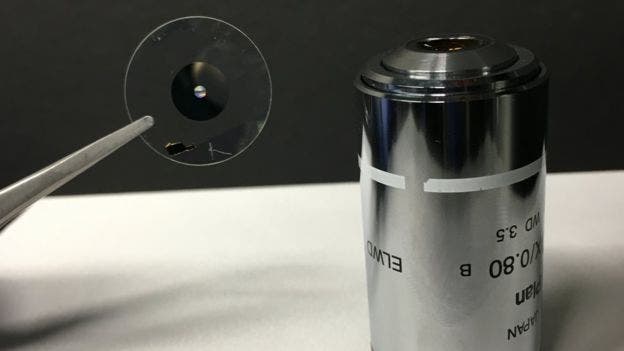To make a clear picture, high power microscopes need to stack multiple lenses. But this sort of instruments could be scaled down to a fraction of their size with a planar or flat lens. Such a lens was recently demonstrated by researchers at Harvard John A. Paulson School of Engineering and Applied Sciences (SEAS). The lens works with high efficiency and within the visible light spectrum.
“This technology is potentially revolutionary because it works in the visible spectrum, which means it has the capacity to replace lenses in all kinds of devices, from microscopes to camera, to displays and cell phones,” said Federico Capasso, Robert L. Wallace Professor of Applied Physics and Vinton Hayes Senior Research Fellow in Electrical Engineering and senior author of the paper. “In the near future, metalenses will be manufactured on a large scale at a small fraction of the cost of conventional lenses, using the foundries that mass produce microprocessors and memory chips.”
The lens is essentially a paint whitener over a thin glass that measures only 2 mm across – finer than a human hair. The metamaterial — a material with properties which can’t be found in nature — is packed with millions of tiny pillars, smaller than the wavelength of light. As such, the lens-light interaction remoulds the rays.
This is how the researchers were able to replicate the focusing ability of conventional lenses with a much smaller, flat lens. Additionally, aberrations inherent in traditional optics are avoided, making the image 30% sharper in comparison with top-end scientific microscopes.
“The quality of our images is actually better than with a state-of-the-art objective lens. I think it is no exaggeration to say that this is potentially revolutionary,” said Prof. Capasso.
These lenses can be made with the same tools used to make computer chips. Capasso argues that this means his lab’s design can be easily mass produced. This means not only more, cheaper top-end microscopes, but also much better smartphone cameras, for instance. Basically, any application that involves optics can benefit from the very first flat lens. Virtual reality goggles, which are pretty bulky and uncomfortable to wear for a long time could be scaled down dramatically, too.
“The amazing field of metamaterials brought up lots of new ideas but few real-life applications have come so far,” said Vladimir M. Shalaev, professor of electrical and computer engineering at Purdue University, who was not involved in the research. “The Capasso group with their technology-driven approach is making a difference in that regard. This new breakthrough solves one of the most basic and important challenges, making a visible-range meta-lens that satisfies the demands for high numerical aperture and high efficiency simultaneously, which is normally hard to achieve.”
“Any good imaging system right now is heavy because the thick lenses have to be stacked on top of each other. No one wants to wear a heavy helmet for a couple of hours,” he said. “This technique reduces weight and volume and shrinks lenses thinner than a sheet of paper. Imagine the possibilities for wearable optics, flexible contact lenses or telescopes in space.”











